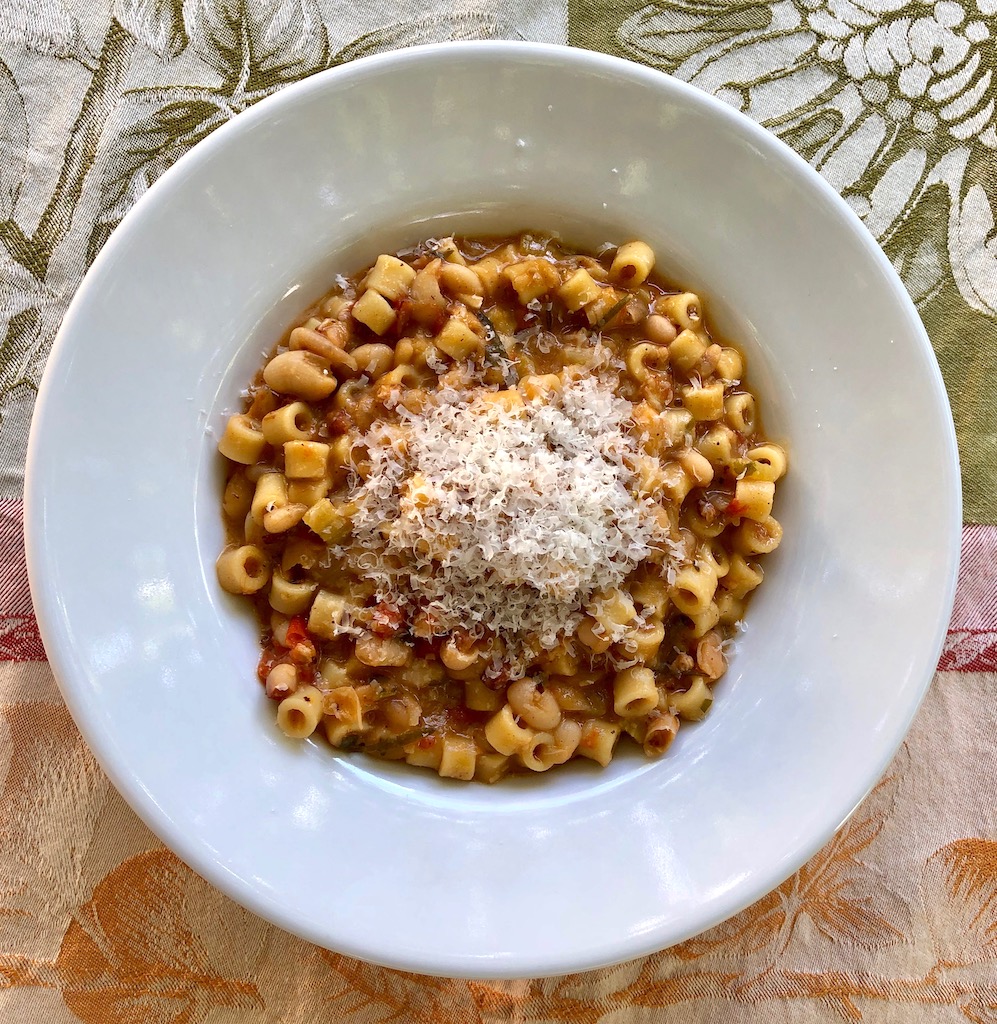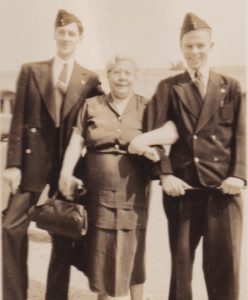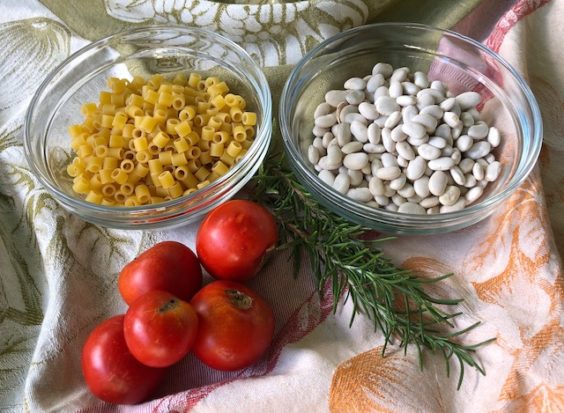
Growing up we called it “pasta fasul”. This warm and comforting thick stew was frequently on the table when the weather turned cool in autumn and downright freezing in winter. Now that the fall weather has arrived in L.A., I made a batch with the last gasp of tomatoes I had from the summer (You have to love L.A., picking tomatoes in October).
It wasn’t until I moved out of the nest that I found out “pasta fasul” wasn’t the real Italian name for this stew. “Pasta e fagioli” is how it’s written in cookbooks; a phrase that to this day is cumbersome to say for me. The name “pasta fasul” is, in truth, an Americanization of the Neapolitan dialect name “pasta e fasule”. It also is well known from the Dean Martin song “That’s Amore” which includes the rhyme “When the stars make you drool, just like pasta fazool, that’s amore”.

Given that my grandmother Maria was from Naples as well as half the Italians in the tiny western New Jersey town of Phillipsburg, this was the only name it was known by. This dish with two main ingredients of cannellini beans and a short pasta is easy to prepare and will stretch over several days because of its stick-to-your-ribs quality.
Now before I start WWIII over this recipe, I want to highlight some approaches I use that might differ from other versions. Here we go:
- I use pancetta as a flavor component – you can’t go wrong with pork fat!
- While I had fresh tomatoes to chop, good quality canned whole tomatoes, crushed, are great too; just use the juice for another purpose.
- This recipe uses Cannellini beans, but borlotti beans are frequently used as well (but harder to find).
- My grandmother would use whatever short pasta she had around, including spaghetti broken into short pieces, but here I use ditalini (see photo)
- The pasta is cooked from start to finish in the bean broth so it imparts its starch; other versions would have you partially cook the pasta separately and add it at the end.

Enjoy!!!
Print
Pasta fasul – a.k.a. – Pasta e Fagioli
- Yield: 4 servings 1x
Description
Start this dish 1 day ahead to easily prepare the beans
Ingredients
- 1/2 lb. dried cannellini or borlotti beans
- 3 rosemary sprigs, 1 whole and 2 leaves removed and chopped
- 1 bay leaf
- Extra virgin olive oil
- 1/4 lb. diced pancetta
- Pinch of red pepper flakes
- 1 medium onion, diced
- 2 celery stalks, diced
- 3 garlic cloves, chopped
- About 6 to 8 small fresh tomatoes, rough chopped or 2 canned plum tomatoes, crushed – remaining tomatoes and juice used for another purpose
- 1 tsp. fresh oregano, chopped and 1 tsp. fresh parsley, chopped
- 1/4 lb. ditalini pasta (or other small pasta shape)
- Parmesan cheese rind
- Grated parmesan cheese
Instructions
- Place the beans in a container with a lid. Cover with twice as much water as the volume of the beans, cover and leave overnight at room temperature.
- The next day, drain the beans and rinse. Add them to a heavy-bottomed pot and add the rosemary sprig and bay leaf. Add twice as much water as the volume of the beans. Cover and bring to boil and then reduce to low simmer with the lid ajar. Cook for 1-1/2 hours. Remove from heat and let cool in the cooking liquid.
- Discard what’s left of the rosemary sprig and bay leaf. Drain the beans with a colander reserving the cooking liquid (this is the secret sauce!).
- Rinse out the same heavy bottom pot and dry.
- Put the pot over medium-low heat and add a splash of extra virgin olive oil. Add the pancetta and a pinch of red pepper flakes and cook, stirring, until the pork is partially browned.
- Add the chopped onions and a pinch of salt. Cook, stirring until the onions are softened. Cover the pot to speed up the process being careful not to brown or burn the onions.
- Add the garlic, chopped rosemary and chopped celery along with another pinch of salt. Cook and stir until the celery is soft and garlic gives off its aroma being careful not to burn the garlic.
- Add the chopped tomatoes and stir. Cover the pot, lifting the lid occasionally to stir until the tomatoes have fallen part and mixed with the pancetta and vegetables to make a thick sauce.
- Add the drained beans and most of the cooking liquid reserving about 1/4 and stir well. Add the parmesan rind and the parsley and oregano. Bring to a boil and then reduce to a simmer. Cook for about 30 minutes adding the reserved bean liquid if it becomes to dense. Taste the liquid at this point since this will be the cooking liquid for the pasta. It should be to your desired saltiness. Remove and discard the parmesan rind.
- Bring the mixture to a boil and then add the pasta. Cook for the time indicated on the package stirring the pasta in the liquid frequently to avoid it from sticking. Pay especially close attention to the corners of the pot.
- Remove from heat and let sit for 1/2 hour. The pasta will absorb most of the remaining cooking liquid and you may have to add some additional water to loosen the stew.
- Serve hot or at room temperature with a sprinkle of grated Parmesan cheese.

Thank you for this recipe, I’m soaking the beans tonight and making this dish tomorrow!
Your grandmother, Maria Egotolmo. Assuming that was her maiden name, no such surname exists in Italy.
Yep, this is the greatest mystery of our family. She was one of 5 girls and no one knows where that last name came from.. Thanks. Joe
My grandmother was second the first generation of her family born in America via Italy. Her maiden name was ‘Ambrose’ shortened from ‘Ambrosetti’ when the family immigrated to the US. Weird things happen when families move across the world, especially back in the day.
I can’t wait to try this recipe! My grandma always made pasta fasul for us growing up (pronounced as such) she grew up in Youngstown, Ohio
I love your story. Thanks for sharing it! Please let us know how your “soup” turns out!! Whenever I think about this comforting dish, I think about the Dean Martin song that mentions it! Joe
I know this is late. I did a little research and that surname did exist in Italy. I did a simple google search and it showed a Lucia Egotalmo was born in Italy in 1885.
Love this – grazie!
Well Ego tolmo means I dare or I venture in Greek, and many southern Italians are of Greek origin!
There are as many recipes for this as there are regions of Italy – maybe more. It seems each region has a different way to make it and they’re all delicious, as is yours.
Thank you!! This is the one we grew up with.. Joe
There are as many versions of this dish as there are Italians, it seems. My friends from Padua make their very soupy, mashing the beans and with very little pasta. Your version looks delicious.
I just read your comments on Pasta fasul. It brought back memories of my Grandmother
Sopfia(think that was how it was spelt). Your memories of how it was said and spelt was exactly my experiences of my grandmothers version. This was back in the fifties in the UK.
Thanks so much for this wonderful comment. I do think food and smell memories are stronger than most. This one is definitely stuck in my head! Joe
my grandmother used to cook this with a knuckle of bacon removing bones and skin at the end. we grew up on this . delicious
Jacqueline: Thanks for the idea!! That sounds delicious!! Joe
joe joe that recipe looks good but mamamia i want to eat now not next week, olive oil in pan onions, let them just start to turn color garlic , canned cannaloni beans with liquid cup water boil add dittalini done twenty mimits add a tablespoon or two of tomatoe paste if you have it .dont mind the spelling
Make this recipe all the time because Deano Martin said it would make me drool. He didn’t disappoint. I was named after him by the way.
Joe, omg this is our new favorite soup! I did puls half of the beans to have a silky texture. I also used cannellini beans instead of borlotti. In my store they call them cranberry beans. Which I will try next time. My mouth is still tingling from the flavors as I write ! Big thanks, my family is in love.
Karin, wow thanks! I’m so happy this really hit the mark for you. This was the “soup” my mom would make on really cold winter days to warm us up. What could be better than pasta and beans. Thanks for the lovely comment. Joe
I also grew up with pasta fasul.My father always made it & I haven’t had it for many years. I’ve been hungry for it all week. Thanks for the recipe.